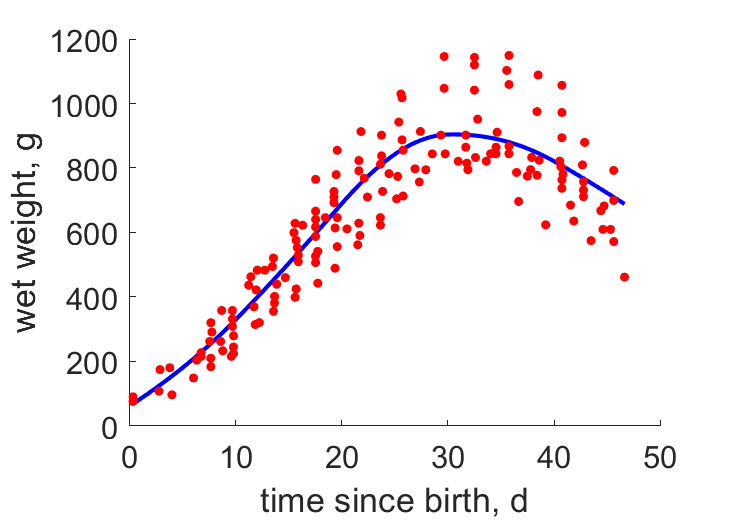Predictions & Data for this entry
| Model: std | climate: MC, ME | migrate: Ml | phylum: |
| COMPLETE = 2.5 | ecozone: MS, MC | food: biCvf, biCic, biCik, bjSv | class: |
| MRE = 0.066 | habitat: 0iMc | gender: Dg | order: |
| SMSE = 0.011 | embryo: Tncfm | reprod: O | family: |
Zero-variate data
| Data | Observed | Predicted | (RE) | Unit | Description | Reference |
|---|---|---|---|---|---|---|
| ab | 46 | 40.72 | (0.1148) | d | age at birth | Creu2010 |
| tx | 53 | 53.01 | (0.0001099) | d | time since birth at fledging | Creu2010 |
| tR | 1095 | 663.9 | (0.3937) | d | time since birth at 1st brood | guess |
| am | 9125 | 9142 | (0.001873) | d | life span | guess |
| Ww0 | 103 | 89.93 | (0.1269) | g | initial wet weight | avibase |
| Wwb | 60 | 63.35 | (0.05576) | g | wet weight at birth | Creu2010 |
| Wwi | 745 | 748.5 | (0.00472) | g | ultimate wet weight for females | avibase |
| Wwim | 845 | 845.5 | (0.0005911) | g | ultimate wet weight for males | avibase |
| Ri | 0.00274 | 0.00274 | (8.219e-05) | #/d | maximum reprod rate | Wiki |
Uni- and bivariate data
| Data | Figure | Independent variable | Dependent variable | (RE) | Reference |
|---|---|---|---|---|---|
| tW |  | time since birth | wet weight | (0.1295) | Creu2010 |
Pseudo-data at Tref = 20°C
| Data | Generalised animal | Fulmarus glacialoides | Unit | Description |
|---|---|---|---|---|
| v | 0.02 | 0.03123 | cm/d | energy conductance |
| kap | 0.8 | 0.9095 | - | allocation fraction to soma |
| kap_R | 0.95 | 0.95 | - | reproduction efficiency |
| p_M | 18 | 5895 | J/d.cm^3 | vol-spec som maint |
| k_J | 0.002 | 0.002 | 1/d | maturity maint rate coefficient |
| kap_G | 0.8 | 0.8005 | - | growth efficiency |
Discussion
- Feeding is reduced towards end of nestling period
- Long tp cannot be captured by std model
- mod_2: Males as assumed to differ from females by {p_Am} only
- mod_2: v is reduced
Acknowledgment
- The creation of this entry was support by the Norwegian Science Council (NFR 255295)
Bibliography